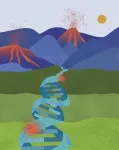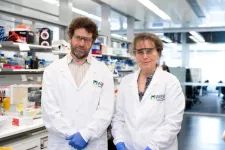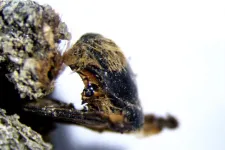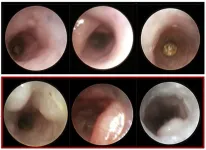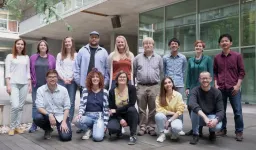Lignocellulose bio-refinery developed for value-added chemical overproduction in yeast
2023-08-24
(Press-News.org)
Lignocellulosic biomass is a renewable feedstock for 2nd-generation biomanufacturing. In particular, efficient co-fermentation of mixed glucose and xylose in lignocellulosic hydrolysates is a key issue in reducing product costs.
However, co-utilization of xylose and glucose in microbes is challenging due to limited xylose assimilation and the glucose repression effect.
Recently, a research group led by Prof. ZHOU Yongjin from the Dalian Institute of Chemical Physics (DICP) of the Chinese Academy of Sciences (CAS) has proposed a microbial platform for lignocellulose bio-refinery. It can efficiently synthesize acetyl-CoA derivatives, such as fatty acids (FFA) and 3-hydroxypropionic acid (3-HP), owing to the enhanced supply of precursor acetyl-CoA and cofactor NADPH by rewiring the cellular metabolism of Ogataea (Hansenula) polymorpha.
This study was published in Nature Chemical Biology on Aug. 24.
The researchers realized co-utilization of glucose and xylose by introducing a hexose transporter mutant and xylose isomerase, and overexpressing the native xylulokinase to enhance xylose catabolism and import.
The engineered strain produced 7.0 g/L FFA from real lignocellulosic hydrolysates in shake flasks and 38.2 g/L FFA from simulated lignocellulose in a bioreactor. Furthermore, this superior cell factory was expanded for 3-HP production by a metabolic transforming strategy, obtaining the highest 3-HP titer of 79.6 g/L from simulated lignocellulose.
“Our work realized co-utilization of xylose and glucose without compromising native glucose metabolism and demonstrated the potential of O. polymorpha as a cell factory to produce versatile value-added chemicals from lignocellulose,” said Prof. ZHOU.
END
[Attachments] See images for this press release:

ELSE PRESS RELEASES FROM THIS DATE:
2023-08-24
Correct and incorrect recommendations inter-mingled in one-third of the chatbot’s responses, making errors more difficult to detect
For many patients, the internet serves as a powerful tool for self-education on medical topics. With ChatGPT now at patients’ fingertips, researchers from Brigham and Women’s Hospital, a founding member of the Mass General Brigham healthcare system, assessed how consistently the artificial intelligence chatbot provides recommendations for cancer treatment that align with National Comprehensive Cancer Network ...
2023-08-24
Researchers at the University of California San Diego have uncovered a connection between the topography of the human genome and the presence of mutations in human cancer. They found that certain regions of the genome, which exhibit unique features, act as hotspots for the accumulation of mutations.
The findings, published recently in Cell Reports, shed light on how the 3D architecture of the human genome may play a role in the development of various forms of cancer.
The human genome is often visualized as the iconic DNA double helix, composed of long sequences of the letters A, C, G and T. “However, the genome ...
2023-08-24
A pioneering drug for a rare kidney disease prevents organ failure and significantly improves the outcome for patients, new research has confirmed.
Atypical Haemolytic Uraemic Syndrome (aHUS) is a genetic life-threatening condition caused by a defect in the immune system which leads to kidney failure.
Newcastle University, UK, carried out clinical trials into the drug, eculizumab, which eventually led to the NHS approving the treatment for use in patients from 2015.
Now, a study by Newcastle experts, published in Blood, ...
2023-08-24
Fubi is produced by cells as a fusion protein with the ribosomal protein S30, and must be separated from S30 by proteases for functioning ribosomes. In immune cells, this by-product of ribosome production is utilized as a secreted signalling molecule, for example to locally reduce the activity of the maternal immune system in the uterus and to thus enable embryos to implant. How Fubi is specifically recognized by proteases and how they distinguish it from ubiquitin was previously unknown.
First author Rachel O’Dea and Malte Gersch explain their research in detail:
What is the discovery that you made and why is it exciting?
Our team revealed ...
2023-08-24
Associate Professor Tim Thomas and Professor Anne Voss from WEHI (Melbourne, Australia) have been awarded the 2023 UNSW Eureka Prize for Scientific Research.
The prize recognises their groundbreaking research in developing a new class of drugs that can put cancer cells ‘to sleep’ without triggering the harmful side effects caused by conventional cancer treatments, like chemotherapy and radiation.
The Australian Museum Eureka Prizes are among Australia’s most distinguished science awards, honouring excellence across the areas of research and innovation, leadership, science engagement, and school science.
At a glance
Associate Professor Tim Thomas and Professor ...
2023-08-24
More than 1 billion cows around the world will experience heat stress by the end of the century if carbon emissions are high and environmental protection is low, according to new research published today in IOP Publishing’s journal Environmental Research Letters.
This would mean cattle farming would face potentially lethal heat stress in much of the world, including Central America, tropical South America, Equatorial Africa, and South and Southeast Asia. The research also found that rapidly reducing greenhouse gas emissions, as well as keeping cattle production close to current levels, would reduce these impacts by at least 50% in Asia, 63% in South America, and ...
2023-08-24
A new study reports the discovery of hundreds of mummified bees inside their cocoons. These cocoons, produced almost three thousand years ago, were discovered in a new paleontological site discovered on the coast of Odemira, in Portugal.
About 2975 years ago, Pharaoh Siamun reigned in Lower Egypt; in China the Zhou Dynasty elapsed; Solomon was to succeed David on the throne of Israel; in the territory that is now Portugal, the tribes were heading towards the end of the Bronze Age. In particular, on the southwest coast of Portugal, where is now Odemira, something strange and rare ...
2023-08-24
The virulence of a rice-wrecking fungus — and deployment of ninja-like proteins that help it escape detection by muffling an immune system’s alarm bells — relies on genetic decoding quirks that could prove central to stopping it, says research from the University of Nebraska–Lincoln.
A Nebraska team helmed by Richard Wilson hopes that identifying an essential but formerly unknown stage in the fungal takeover of rice cells can accelerate the treatment or prevention of rice blast disease, which ruins up to 30% of global yields each year.
“The response I’ve gotten from people in my field is that they’re very excited, ...
2023-08-24
Researchers at the University of Florida College of Medicine have discovered how common age-related changes in the blood system can make certain colon cancers grow faster. The study, to be published August 24 in the Journal of Experimental Medicine (JEM), also suggests how these effects might be therapeutically targeted to reduce tumor growth and improve patient survival.
As we age, the hematopoietic stem cells that reside in the bone marrow and give rise to all of the body’s different blood cells gradually acquire mutations in their ...
2023-08-24
Researchers at the Centre for Genomic Regulation (CRG) have discovered how proteins work in tandem to regulate ‘treadmilling’, a mechanism used by the network of microtubules inside cells to ensure proper cell division. The findings are published today in the Journal of Cell Biology.
Microtubules are long tubes made of proteins that serve as infrastructure to connect different regions inside of a cell. Microtubules are also critical for cell division, where they are key components of the spindle, the structure which attaches itself to chromosomes and pulls them apart into each new cell.
For the spindle to function properly, cells rely on microtubules to ‘treadmill’. ...
LAST 30 PRESS RELEASES:
[Press-News.org] Lignocellulose bio-refinery developed for value-added chemical overproduction in yeast

